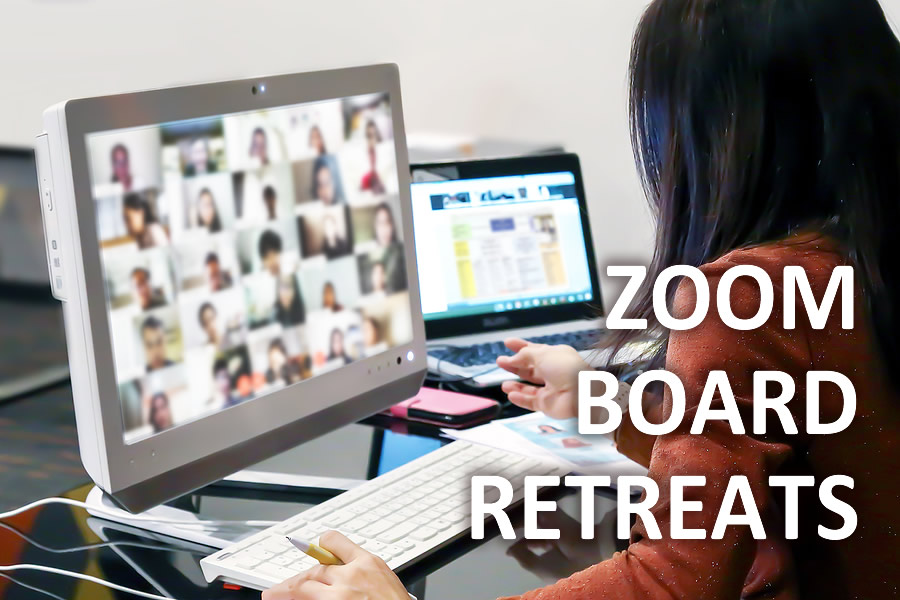
If you haven’t had a board retreat yet this year, this post is for you!
That’s because every nonprofit board should have an annual retreat. And this year is no exception. If anything, a board retreat is more critical than ever as we begin to recover from the COVID-19 pandemic.
Board Retreat Agenda Items for Zoom
There are three must-have agenda items at any board retreat, and these can easily be extended to virtual meetings on Zoom or another platform.
Agenda Item #1: Team Building
I don’t care how well you think your board members know one another, team building is an important component of working together and serving on a board.
If your board members truly know one another, then it’s a red flag that you haven’t recruited any new board members recently, and likely that most of your members have been serving too long. (Make a note to check your bylaws with regard to term limits.)
Although you may know all of your board members well, it’s unlikely that even with monthly meetings, they feel they know one another. Use name tags at each meeting. Zoom makes this especially easy. If some members don’t have their full name displayed, remind them how to change their name on their “Hollywood square.”
Stick with introductions, not ice-breakers.
Start any retreat with a fun team-building activity. Don’t call it an “ice-breaker” on your agenda, because that will immediately have some members rolling their eyes. Simply list “introductions and welcome” and slip an activity in.
At the beginning of your retreat, go around the Zoom room and call on everyone by name. Don’t ask who will go next. Instead, call on people by name — for example, “Amy, will you please share…”
This is an important technique to get everyone participating throughout your time together.
Agenda Item #2: Planning
Planning for your organization’s future is a critical aspect of any board retreat.
Depending on where you are in the life-cycle of your organization, you might be reviewing a current strategic plan or gearing up to create a new one.
Try Zoom breakout rooms.
Take advantage of Zoom breakout rooms and split a larger group up for small group discussion (three to five people per group). Separate staff members, so there’s at least one staff member per group.
Provide specific instructions in terms of how much time they will be in breakout rooms, as well as what they should be discussing. Remind each group to select a note-taker who will report out to the larger group.
Make sure to end with key takeaways and next steps. A next step might be for a subcommittee to explore the ideas generated at the retreat. No final decisions need to be made on the spot.
Agenda Item #3: Fundraising
Last but not least, every board retreat must have a discussion or training around the topic of fundraising. One mistake I see some organizations make is devoting an entire retreat to planning, without any means of funding their plan.
If you expect board members to help with fundraising, you must provide the tools, resources, training, and confidence they need to be successful. Fundraising training is not a one-and-done situation. You can provide in-depth training at your annual retreat, and then shorter, discussion-based follow-up at each board meeting throughout the year.
In advance of your retreat, reach out to board members who have helped with fundraising. Ask them to share a short story about why fundraising is important to them and how they achieved success (or overcame their fear). Don’t only highlight those who asked for gifts, but also ask those to share who helped make introductions, made thank you calls, etc.
Consider the 4 Fundraising Stages for inspiration.
There are many ways to help with fundraising, in addition to asking. You can brainstorm a list of all the ways board members might help with fundraising. Start the ball rolling by explaining that there are four stages to fundraising:
- Donor Identification
- Cultivation (relationship building)
- Solicitation (asking)
- Stewardship (thanking and follow up)
Send small groups into breakout rooms and ask them to come up with a list of “Easy, Medium, and Difficult” ways to help with fundraising, keeping in mind the four stages above.
Remember, stuffing envelopes is probably easy for most people. However, making thank-you calls might be easy for some and difficult for others. Encourage them to put tasks in more than one place if there is disagreement among group members… there’s no wrong answer.
Encourage groups to come up with as many ideas as possible. Report back to the larger group and ask each person to select 3 ways, from the long list, that they would be willing to help with fundraising.
Zoom Retreat or In-Person Retreat?
As of the writing of this post (late March 2021), social distancing restrictions are largely still in place. Covid-19 isn’t quite behind us yet. That said, many people have already been vaccinated, outdoor weather is upon us, and some organizations may be able to meet in-person (with appropriate safety measures).
Regardless of whether your board retreat is on Zoom or in-person, these three agenda items are essential. Make sure to devote a good chunk of time to each.

I love your blog. Do you have other Fundraising activities that you can suggest for boards or staff who are new to fundraising? I have to do some fundraising zooms and am searching for activity inspiration that doesn’t have people fleeing or rolling their eyes!
This is very important for my organization. Thank you!